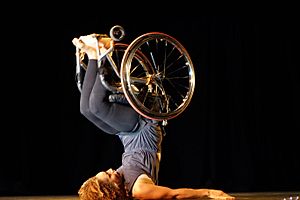Alice Sheppard facts for kids
Alice Sheppard is an amazing dancer and choreographer from Britain. She is also a disabled artist. Alice first worked as a university professor. But then, she saw a dancer named Homer Avila perform. This inspired her to change her path and become a dancer herself!
Alice joined the AXIS Dance Company and toured with them. Later, she started her own dance company called Kinetic Light. She created Kinetic Light with other talented disabled dancers and artists, including Laurel Lawson, Jerron Herman, and Michael Maag. Michael also helps with lighting and video for their shows. Alice's dance work often explores how her different identities, like being disabled and a person of color, connect and influence her art.
Contents
Alice's Journey to Dance
Alice Sheppard studied at Cornell University and earned a special degree. She then became a professor at Pennsylvania State University (PSU). In 2004, she went to a conference about disability studies. There, she saw Homer Avila dance. His performance truly inspired her.
After talking with Homer, Alice decided to try a dance class. At the same conference, she also met Simi Linton. Simi made a film called Invitation to Dance, which featured Alice. The film's director, Christian von Tippelskirch, said Alice was a "central figure" and an "amazingly talented" dancer.
Alice's first dance lesson was with Kitty Lunn. Two years later, Alice left her teaching job to focus on dance. She continued her lessons with AXIS Dance Company. She became an apprentice dancer in 2006 and a full company member in 2007. Alice had studied ballet and modern dance before.
During her time as an apprentice, Alice learned how to dance while using a wheelchair. She discovered how disability can create its own unique and beautiful movements. She learned to truly listen to her body. After her apprenticeship, Alice toured all over the country. She also taught dance for the Axis Dance Company's education programs. In 2012, she became an independent dancer. Since then, she has worked with dance companies in both the United Kingdom and the United States.
Alice is multiracial and a Black Briton. She prefers not to share specific details about her disability.
Alice's Dance Career
In 2014, Alice worked with GDance and Ballet Cymru to create a show called Stuck in the Mud. This was an interactive performance where the dancers guided the audience through the space. She also performed with Full Radius Dance in 2014 and 2015.
In 2017, she teamed up with the Marc Brew Company to create BREWBAND. This show mixed live rock music with live dance. It aimed to blend musicians and dancers and change how audiences see live performances.
Also in 2017, Alice's dance company, Kinetic Light, created a piece called Descent. This performance took place on a special ramp structure. It told the story of Andromeda and Venus as reimagined lovers. Alice performed Descent with Laurel Lawson while both were in wheelchairs.
In 2017, Alice Sheppard received a special award from Gibney Dance. This award gave her resources to create and perform new dance works. In February 2018, Alice performed at the opening of a new space at the Gibney Dance Center. She also spoke at a conference about growing disability dance in New York City.
In July 2018, Alice was featured on the cover of Dance Magazine. The magazine said she was "moving the conversation beyond loss and adversity." In February 2019, she was featured in The New York Times article, "I Dance Because I Can." This article highlighted the work of Alice and Laurel Lawson from Kinetic Light. It showed how their art connects with ideas of fairness and equality, and how their work comes from disability culture and beauty.
In January 2019, Alice was one of 58 artists to receive the Creative Capital award.
Alice's Dance Style
Alice creates dances that challenge common ideas about disabled bodies and dancing. She uses ideas from disability arts, culture, and history in her work. She is very interested in how disability, gender, and race connect. This interest often leads her to work with other artists.
In her dances, Alice uses her wheelchair as if it's an extension of her own body. She also uses crutches in some of her routines. In 2016, she started using ramps in her performances. These ramps were built by engineering students at Olin College.
Alice's work does not show old, untrue ideas about disability. Instead, her dances explore her many different identities. She wants to be honest and tell the complex stories and cultures of disability, race, and gender. She believes that disability is more than just a medical diagnosis. She sees it as a form of beauty, a mix of cultures, and a powerful creative force. She also believes that movements don't just show "triumph over disability."
Below is a list of dances choreographed by Alice Sheppard:
| List of Works | Date |
|---|---|
| Doors | 2013 |
| I Belong to You | 2014 |
| So, I Will Wait | 2015 |
| Succumb | 2016 |
| Re-Membering a World to Come | 2016 |
| Trusting If/Believing When | 2017 |
| Where Good Souls Fear | 2017 |
| Descent | 2017 |
| REVEL IN YOUR BODY: a dance film story | 2019 |
| INCLINATIONS: a dance film | 2019 |
Awards and Grants
Alice Sheppard has received many awards and grants for her amazing work:
- Wynn Newhouse Award (2015)
- Dance/NYC Disability Dance Fund (2017)
- Creative Capital Foundation's MAP FUND (2017)
- New England Foundation for the Arts [NEFA]: The NDP Production grant (2017)
- Dance Magazine's Reader's Choice Award: Most Moving Performance (2018)
- United States Artists Fellowship (2019)
- Creative Capital Award (2019)
Public Speaking
Alice Sheppard also gives talks to share her ideas.
- "Does Disability Need Fixing?" at HUBweek (2018)



